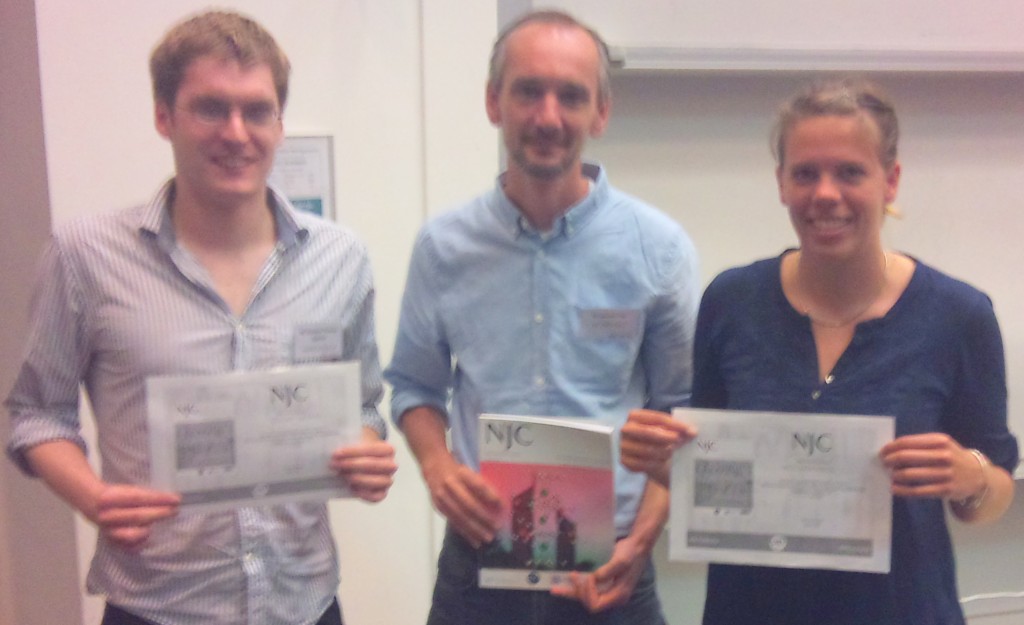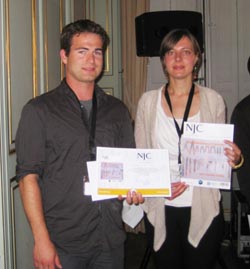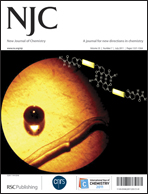Here is a selection of author profiles from the August issue of NJC. The editorial team would like to warmly thank them for accepting the invitation, giving us the opportunity to know some of our fellow chemists a little better.

Our first author is Stefan Bräse, who is Full Professor for Organic Chemistry and has been the Dean of the Faculty of Chemistry and Biochemistry for four consecutive years at the Karlsruhe Institute of Technology (KIT) in Karlsruhe, Germany. His research interests cover a wide range of organic chemistry reaching from total synthesis over solid phase chemistry to molecular transporters and carbohydrate chemistry. For some time now, Stefan Bräse has also been interested in nanosciences with a special focus on material chemistry. He is an active member of the Center for Functional Nanostructures (CFN) and, very recently, the Karlsruhe School of Optics and Photonic (KSOP) within the KIT. His latest contribution to NJC is a joint research project with colleagues from the KIT and Italy and deals with the generation and characterization of a Hyper-Cross-linked Polymer via Click chemistry. An adamantane based HCP exhibits efficient CO2 capture at low pressure
Besides the lab Stefan enjoys gardening around his recently finished house and spending time with his wife and their 10 months old son. Stefan is also keen on taking part in his group’s famous summer barbecue evenings.
“Click chemistry produces hyper-cross-linked polymers with tetrahedral cores”, Oliver Plietzsch, Christine I. Schilling, Tobias Grab, Stephan L. Grage, Anne S. Ulrich, Angiolina Comotti, Piero Sozzani, Thierry Muller and Stefan Bräse, New J. Chem., 2011, 35, 1577-1581. DOI: 10.1039/C1NJ20370C.
 Scott McIndoe is Associate Professor at the University of Victoria, Canada. He is currently working in the field organometallic catalyst discovery using ESI-MS . In this NJC paper, Scott and coworkers were interested in ensuring that their ESI-MS results are representative of solution speciation, and they discovered some interesting phenomena when exploring the degree to which they could leave ions partially solvated. They found that some fundamental solution properties of ions, notably their acidity, are reflected in their gas-phase behavior.
Scott McIndoe is Associate Professor at the University of Victoria, Canada. He is currently working in the field organometallic catalyst discovery using ESI-MS . In this NJC paper, Scott and coworkers were interested in ensuring that their ESI-MS results are representative of solution speciation, and they discovered some interesting phenomena when exploring the degree to which they could leave ions partially solvated. They found that some fundamental solution properties of ions, notably their acidity, are reflected in their gas-phase behavior.
On choosing NJC to publish this work, Scott comments that “It touches on a broad range of topics, from the lanthanide contraction to ion acidity to the details of the electrospray ionisation mechanism, so we thought it deserved a broad audience”.
Outside of the lab, getting his hands dirty designing, making, and growing things is Scott’s favorite activity. If he could not be a scientist, he would be a professional cricketer.
“Blurring the line between solution and the gas phase: collision-induced dissociation of hypersolvated lanthanide trications provides insights into solution acidity”, Jennifer Pape, Keri McQuinn, Fraser Hof and J. Scott McIndoe, New J. Chem., 2011, 35, 1582-1587. DOI: 10.1039/C1NJ20105K.

The next author is Plinio Innocenzi, Full Professor of Materials Science and Head of the Materials Science and Nanotechnology Laboratory at the University of Sassari, Italy. His research group is currently working on self-assembled nanomaterials, hybrid sol-gel materials for photonics, and X-ray lithography for soft matter. In their paper, Plinio and his team explore the possibility of using self-assembly to fabricate hierarchical porous materials as a very challenging road to master complexity. They believe that controlling the porosity in a material in terms of size and shape through a one-pot synthesis is a little step forward to get more complex materials.
The wide diffusion of NJC, with a particular attention to innovative nanochemistry synthesis, was Plinio’s motivation behind his submission to the journal.
Outside the lab, Plinio appreciates spending time with my family. Beside this he really like swimming : “I swim a couple of km almost every day, this is a very nice way of relaxing and thinking about science. I like also reading and sailing (sometimes at the same time…).” Because Plinio is so much happy to be a scientist, he cannot imagine to do anything else.
“Controlling shape and dimensions of pores in organic–inorganic films: nanocubes and nanospheres”, Plinio Innocenzi, Luca Malfatti, Daniela Marongiu and Maria F. Casula, New J. Chem., 2011, 35, 1624-1629. DOI: 10.1039/C1NJ20186G.

Closing this month’s selection, we are pleased to present Michael H. Abraham, Honorary Professor at the University College London, UK. Michael research focuses on physical organic chemistry, especially as applied to environmental chemistry and medicinal/pharmaceutical chemistry. His paper contributes to the considerable discussion on the role of ion pairs in water-solvent partition and in membrane partition and permeation. It has been difficult to reach any conclusions so far, mainly because little is known about any properties of ion pairs that are relevant to partitioning and permeation processes. The aim in starting this work was to obtain physicochemical properties (or descriptors) of ion pairs that would allow quantitative assessment of the ability of ion pairs to undergo partition and permeation, especially by comparison to ionic species and neutral molecules.
“NJC is a highly regarded journal that covers a wide range of chemistry, including physical organic chemistry. The chosen reviewers for our manuscripts that we have previously submitted have always been knowledgeable and very perceptive, and an additional advantage is that time to publication is short.”, says Michael.
Michael is also a professional artist (painter) and so a great deal of his activity revolves around the practice of painting. This includes not only painting in the studio, but going out looking for sites for landscape painting, and a lot of time spent in setting up exhibitions. Michael also very keen on classical music concerts especially chamber music. When asked for an alternative career path if not a scientist, Michael naturally answered: “I suppose that my other profession, that as an artist, would have taken over as my sole profession.”
Thanks to all of you, and see you next month for more!
Fancy submitting an article to NJC? Then why not submit to us today or alternatively email us your suggestions.
Comments Off on Meet Our Authors – August 2011
























